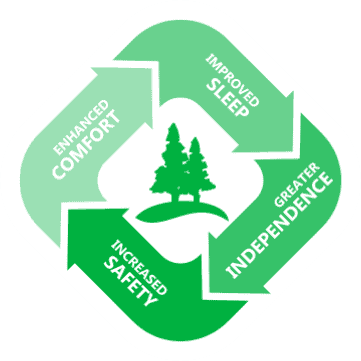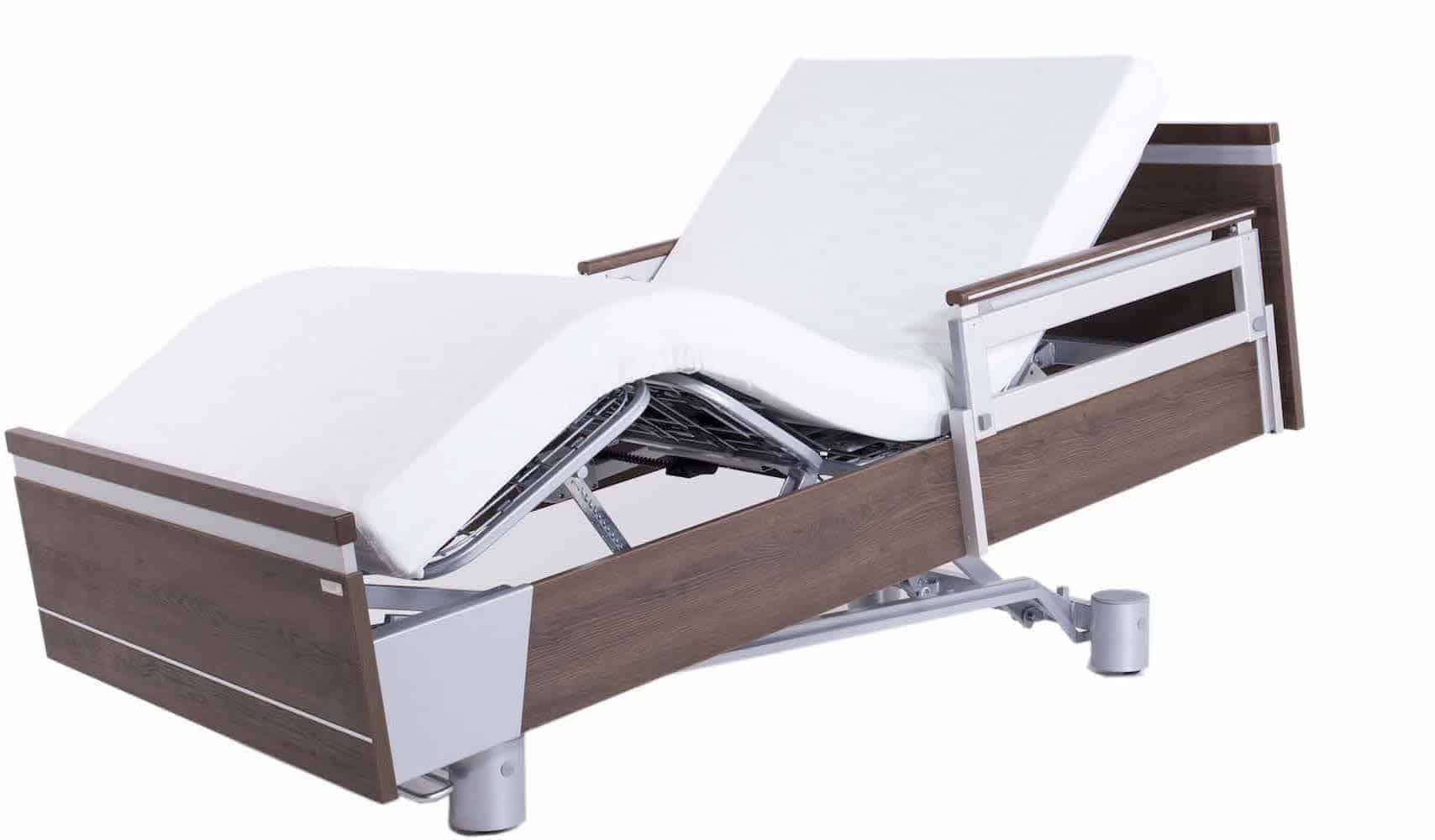Learn About Getting A Bedridden Patient Out Of Their Hospital Bed and Into Rehab
| Key Takeaways |
|---|
| ✅ Getting a bedridden patient out of a hospital bed requires proper preparation, equipment, and assistance. |
| ✅ The patient should be positioned on their side near the edge of the bed, with their legs bent and their upper body supported by pillows. |
| ✅ The caregiver should use a gait belt or a transfer board to help the patient slide or pivot to a wheelchair or a chair. |
| ✅ The caregiver should use proper body mechanics and avoid twisting, bending, or lifting the patient. |
| ✅ The caregiver should communicate with the patient and check for signs of pain, dizziness, or discomfort during the transfer. |
Getting out of your hospital bed and eventually out of a extended bed rest orders is a challenge and requires careful planning and guidance from healthcare professionals. The ability to climb out of a hospital bed depends on various factors such as the patient’s condition, mobility level, strength, endurance, and coordination. Patients who have been immobilized for an extended period may find it challenging to move around or perform basic activities independently.
Patients can, however, regain muscle strength and joint flexibility over time with proper rehabilitation and physical therapy. A series of essential strategies are explored below that can help patients get out of a hospital bed safely and become independent in their recovery process.
Understanding the Reasons for Bed Rest in a Hospital Bed
In many cases, doctors prescribe bed rest as a way to reduce physical activity, promote tissue healing, reduce inflammation, and prevent further complications. Injuries or illnesses can be treated with bed rest without placing additional pressure on affected areas. In addition, prolonged immobility reduces the risk of blood clots forming in the legs. Patients who need time to recover from surgical procedures may benefit from bed rest as well.
Extensive bed rest can, however, cause muscle atrophy, bone loss, decreased cardiovascular function, and reduced lung capacity. During prolonged periods of bed rest, healthcare professionals usually prescribe exercises or physical therapy sessions that maintain muscle strength and mobility. In order to prevent long-term complications of immobility, these interventions are crucial.
During times of boredom or frustration in a hospital bed, patients may attempt to climb out against medical advice. Such actions, while understandable, can be dangerous and worsen a patient’s condition by exposing them to possible injuries. Caretakers and medical personnel must work closely together to make sure that patients remain comfortable and safe while resting in bed.
Understanding why bed rest is necessary and what steps can be taken during this time will allow individuals to assess their condition accurately while maintaining mobility safely when possible. Patients should work closely with healthcare professionals throughout their treatment journey; this collaboration will ensure optimal outcomes as they move towards recovery.
Assessing Your Condition and Mobility Outside Of A Hospital Bed
An important factor in determining the patient’s ability to move independently is their physical condition and mobility.
Identifying underlying medical conditions that may affect mobility is the first step in assessing the patient’s overall health condition. When an individual understands the severity of his or her illness and how it affects different parts of the body, they can determine how much movement is safe and appropriate.
A patient’s mobility is also assessed based on several other factors. As well as age, weight and height, muscle strength, balance, and coordination, there are other factors to consider.
Furthermore, a person’s mental wellbeing plays a critical role in their ability to move independently. Having anxiety or depression can lead to feelings of weakness or unsteadiness.
Surgical procedures and prolonged bed rest after an injury or illness may also temporarily impair mobility. Soon after the procedure, patients are encouraged to engage in light exercises such as stretching or taking short walks.
Before trying to climb out of a hospital bed, it is essential to assess your physical condition and mobility. Here are five reasons why:
- Moving too soon puts you at risk of re-injury.
- Painful movements could lead to further complications.
- Restricted movement causes muscles to weaken.
- Loss of mobility increases susceptibility to falls.
- Ignoring your care team’s advice could delay your recovery.
You should always communicate with your doctor or care team about what activities you would like/need to do next before you attempt any movement that goes against their instructions. In this way, everyone stays on the same page about the kind of treatment plan that will work best for you while also allowing for any necessary adjustments.
Communicating with Your Home Health Care Team
Communicating effectively with healthcare providers is crucial in ensuring optimal patient outcomes, as studies show that patients who have good communication with their care team experience better health outcomes and a higher level of satisfaction with their care. When it comes to addressing whether someone can climb out of a hospital bed, effective communication between the patient and healthcare provider is essential. Patients should express any concerns or questions they have regarding their mobility and ask for clarification on any instructions given by the care team.
To help facilitate communication, patients can use various techniques such as active listening, asking open-ended questions, and repeating back information to ensure understanding. Additionally, patients should inform the care team of any changes in condition or pain levels that may affect their ability to move safely. This information allows the care team to make necessary adjustments to the rehabilitation plan.
A helpful tool in facilitating communication between patients and healthcare providers is a table outlining common barriers to mobility and suggestions for overcoming them. The table could include barriers such as pain, fear of falling, weakness, or confusion. Suggestions for overcoming these barriers could include utilizing assistive devices like walkers or handrails, practicing safe techniques for transferring from bed to chair or vice versa, engaging in physical therapy exercises regularly, and addressing underlying medical conditions contributing to weakness or confusion.
Effective communication between patients and healthcare providers is critical when it comes to addressing mobility issues during hospitalization. By utilizing techniques like active listening and providing clear information about changes in condition or pain levels, patients can work collaboratively with their care team towards developing a rehabilitation plan that addresses individual needs and goals for recovery. In the next section we will explore how individuals can develop an effective rehabilitation plan tailored specifically towards their unique needs.
Developing a Rehabilitation Plan To Rely Less On Hospital Beds
Developing an effective rehabilitation plan is crucial for patients to achieve their individualized goals and address mobility issues during hospitalization. For instance, a patient who has undergone hip replacement surgery needs to regain strength in order to walk comfortably again.
An effective rehabilitation plan should include the following:
- Assessment of the patient’s current physical condition and functional abilities.
- Setting realistic goals with the input of the patient and their care team.
- Development of a personalized exercise program that includes stretching, strengthening, and endurance training.
- Regular monitoring and adjustment of the program based on progress made.
Establishing goals with the patient is one of the most important aspects of developing a successful rehabilitation plan. This encourages them to be involved in the recovery process. A regular review of progress made towards these goals should also be conducted by the care team, with adjustments as needed. Taking an active role in your rehabilitation program will not only improve functional abilities but will also contribute to your overall wellbeing.
An individualized rehabilitation plan can include physical therapy exercises to help patients regain strength, flexibility, balance, and coordination after surgery or illness. In physical therapy, exercises are performed under supervision to target specific muscle groups while also taking the patient’s limitations and pain into account.
These exercises may include range-of-motion exercises, resistance training using weights or resistance bands, balance training using specialized equipment such as stability balls or foam pads, and cardiovascular conditioning through activities such as walking or cycling.
During hospitalization, many patients have difficulty transitioning from bed rest to full mobility. There is, however, hope for those who wish to emerge from their hospital beds with renewed vigor and confidence if an effective rehabilitation plan is developed that includes personalized exercise programs aimed at achieving set goals – all the while keeping patients engaged throughout their recovery journey.
Incorporating Physical Therapy Exercises
During hospitalization, physical therapy can improve patients’ functional abilities, mobility, and overall well-being by incorporating targeted exercises. As part of physical therapy exercises, the patient’s range of motion, muscle strength, balance, coordination, and endurance are improved. Personalized exercises are designed for patients based on their medical history, current condition, and recovery goals. Physicians and nurses work closely with physical therapists to monitor and adjust exercise regimens as needed.
Some of the most common physical therapy exercises that may be included in a rehabilitation program are shown in the following table:
| Exercise | Purpose | Examples |
|---|---|---|
| Range of Motion (ROM) Exercises | Increase joint flexibility and prevent contractures | Ankle pumps; shoulder shrugs |
| Strengthening Exercises | Improve muscle strength and endurance | Leg press; bicep curls |
| Balance Exercises | Enhance stability and reduce fall risk | Standing on one leg; tandem walking |
| Endurance Exercises | Improve cardiovascular health and stamina | Treadmill walking; stationary bike |
Physical therapy exercises not only help patients recover from injuries or surgeries but also aid in preventing future complications such as blood clots or pressure sores. In addition to these benefits, physical therapy can also have a positive impact on mental health by reducing stress levels and improving mood. Patients who engage in regular physical activity through physical therapy often report feeling more empowered throughout their recovery journey.
Complementing physical therapy exercises with assistive devices and equipment is an important part of a comprehensive rehabilitation program. Including both elements in the treatment plan can ensure that patients are discharged from the hospital with maximum functional independence. A wheelchair or a walker, for example, allows patients to continue their exercise regimen while minimizing pain or discomfort. As a result, a patient’s quality of life can be significantly improved with an individualized rehabilitation plan that includes targeted physical therapy exercises and assistive devices.
Using Assistive Devices and Equipment Like A Home Hospital Bed
Previously, we discussed the importance of incorporating physical therapy exercises into a patient’s recovery plan. While these exercises are crucial for improving strength and mobility, they may not be enough for some patients to climb out of a hospital bed on their own. This is where the use of assistive devices and equipment comes in.
Assistive devices and equipment can help patients perform movements that would otherwise be too difficult or painful. For example, a patient who has undergone hip surgery may need a walker or crutches to avoid putting weight on their healing joint. Other examples of assistive devices include grab bars, transfer benches, and raised toilet seats.
It is important to note that while these tools can be incredibly useful in aiding patient mobility, they should only be used under the guidance of a healthcare professional. An occupational or physical therapist can assess a patient’s needs and recommend appropriate assistive devices such as a luxury home hospital bed based on their individual circumstances.
In addition to making it easier for patients to move around, assistive devices can also improve safety by reducing the risk of falls or other injuries using a certified home hospital bed. By using these tools as directed by healthcare professionals, patients can take an active role in their own recovery process.
As patients become more comfortable using assistive devices and equipment, they may begin to focus on building strength and endurance through additional exercises and activities. In our next section, we will explore how this transition can occur seamlessly with the right support system in place.
Building Strength and Endurance to Reduce Dependence on Equipment
Improving strength and endurance is a critical component of the recovery process, and this section provides valuable insights into how patients can achieve these goals with appropriate support and guidance. Building strength and endurance helps patients regain their mobility, independence, and quality of life. It’s important to note that each patient has unique needs, strengths, and limitations that need to be considered when creating an individualized exercise program.
The first step towards building strength and endurance is setting realistic goals. Patients should work closely with their healthcare providers to determine what exercises are safe for them to perform based on their medical history, current condition, age, weight, etc.
The exercise program should include a variety of activities such as stretching exercises to improve flexibility; resistance training using weights or bands to build muscle mass; aerobic exercises like walking or cycling to improve cardiovascular fitness; balance training to prevent falls; and functional exercises that mimic daily activities such as getting in/out of bed or standing up from a chair.
It’s important for patients not to overdo it when starting an exercise program as this may lead to injury or setbacks in their recovery. Gradually increasing the duration, frequency, intensity of the exercises will help build endurance without causing undue stress on the body. Patients should also listen carefully to their bodies’ signals during exercise – if they experience pain or discomfort while exercising they should stop immediately.
In summary, building strength and endurance requires patience, dedication, and guidance from healthcare professionals. By setting realistic goals that are tailored for each patient’s unique needs and abilities patients can safely improve their mobility while reducing the risk of falls or injury. Practicing safe transfers and movement is key in ensuring success in achieving these goals.
Practicing Safe Transfers and Movement
Having discussed the importance of building strength and endurance in the previous subtopic, we will now shift our focus towards practicing safe transfers and movement.
As patients begin to regain their strength, it is critical that they learn how to move safely without risking further injury or setbacks.
Safe transfer techniques involve learning how to properly sit up, stand up, and walk with assistance from a caregiver or physical therapist. These techniques not only aid in safety but also help build confidence and independence for the patient. Additionally, proper body mechanics during movement can prevent strain on muscles and joints.
It is important for patients to be aware of their limitations and communicate any discomfort or pain during movements. Physical therapists can provide guidance on exercises that target specific muscle groups needed for mobility while ensuring that patients do not overexert themselves.
In summary, practicing safe transfers and movement is crucial for individuals recovering from illness or injury. It helps minimize the risk of further complications while promoting independence and confidence. By working closely with physical therapists and caregivers, patients can gradually improve their mobility while staying mindful of their limitations.
Moving forward, let us explore ways to monitor progress and adjust our plan accordingly as we continue on the road to recovery.
Monitoring Your Progress and Adjusting Your Plan
This section will delve into the importance of monitoring progress and adjusting plans in order to optimize recovery outcomes for patients. When a patient is hospitalized, the healthcare team creates an individual care plan that outlines specific goals and interventions. However, it is important to recognize that a patient’s condition can change rapidly, which may require changes to the care plan.
Monitoring progress involves regularly assessing the patient’s physical and mental well-being, evaluating their response to interventions, and modifying the plan accordingly. The healthcare team uses various tools to monitor progress and make necessary adjustments. For instance, they may use vital signs such as blood pressure, heart rate, or oxygen saturation levels as objective measures of a patient’s health status. They may also use subjective assessments like pain scales or questionnaires to evaluate how the patient is feeling. These tools help identify any areas where the current care plan is not effective or needs modification.
Making appropriate changes to a care plan can result in improved recovery outcomes for patients. For example, if a patient is not progressing as expected towards achieving their independence goals (such as being able to climb out of bed), it may be necessary to adjust their rehabilitation program or medication regimen. By continuously monitoring progress and making adjustments when needed, patients have a greater chance of achieving optimal recovery outcomes.
Transitioning from hospitalization back into daily life requires careful planning and support from healthcare professionals. The next section will discuss strategies for achieving independence and discharge goals while maintaining optimal health outcomes for patients.
Achieving Independence and Discharge Goals
he current section focuses on the strategies and interventions that healthcare professionals can implement to assist patients in achieving their independence and discharge goals while maintaining optimal health outcomes. Achieving independence is a crucial aspect of patient care, as it allows patients to regain control over their lives and promotes a sense of self-efficacy. Healthcare professionals play an essential role in helping patients achieve this goal by providing them with the necessary resources, support, and education.
Using early mobilization as a strategy to promote patient independence is one way healthcare professionals can assist patients. Patients who are recovering from surgery or illness should be mobilized as soon as possible. It has been shown that this approach reduces the risk of complications such as pneumonia, blood clots, and muscle weakness. A quicker recovery can also be achieved with early mobilization, which helps patients regain strength and mobility more quickly.
Another intervention that healthcare professionals can use is patient education. Educating patients about their condition, treatment options, and self-care techniques empowers them to take an active role in their recovery process. By understanding their condition better, patients are more likely to comply with treatment plans and make lifestyle changes that promote optimal health outcomes. Patient education also helps reduce anxiety and stress levels by providing them with the knowledge they need to manage their symptoms effectively.
The completion of an independent care plan requires collaboration between healthcare professionals and patients themselves. Using strategies like early mobilization and patient education, healthcare providers can help patients achieve their discharge goals and promote optimal health. By reducing hospital stays’ length and readmission rates, these interventions benefit not only individuals, but also the healthcare system as a whole. Both the individual and society will benefit from empowering individuals with knowledge about their health conditions.
In conclusion, it is possible to Get A Bedridden Patient Out Of A Hospital Bed with the right rehabilitation plan and support from their care team. Bed rest may be necessary for certain medical conditions or after surgery, but prolonged immobility can lead to muscle weakness, joint stiffness, and other complications. It is important to assess your condition and mobility before attempting any physical activity, communicate openly with your care team about your goals and limitations, and follow a structured rehabilitation plan that includes physical therapy exercises.
- Getting a bedridden patient out of a hospital bed requires proper preparation, equipment, and assistance.
- The patient should be positioned on their side near the edge of the bed, with their legs bent and their upper body supported by pillows.
- The caregiver should use a gait belt or a transfer board to help the patient slide or pivot to a wheelchair or a chair.
- The caregiver should use proper body mechanics and avoid twisting, bending, or lifting the patient.
- The caregiver should communicate with the patient and check for signs of pain, dizziness, or discomfort during the transfer.
- Understanding the reasons for bed rest in a hospital bed is crucial for the patient’s recovery process.
- Patients should work closely with healthcare professionals throughout their treatment journey to ensure optimal outcomes.
Frequently Asked Questions About Reducing Time Spent Bedridden In Hospital Bed
Safety is paramount when moving a bedridden patient. It’s important to communicate clearly, move slowly and carefully, ensure the patient is comfortable, and use proper lifting techniques or equipment to prevent injury to both the patient and caregiver.
Generally, the patient should be gently rolled onto their side, helped to a sitting position with legs hanging over the edge of the bed, and then assisted to stand or move to a wheelchair with the support of a caregiver or a transfer device.
First, communicate clearly about what will happen to reassure the patient. Ensure the bed is at a safe height for movement, the patient’s feet can touch the floor, and the wheels of the bed are locked. Remove any obstacles in the way.
Equipment like slide sheets, transfer boards, patient lifts, and transfer belts can help safely move a bedridden patient. The choice of equipment depends on the patient’s physical condition and the caregiver’s training and strength.
A patient lift should be used when a patient cannot bear weight or assist with their transfer, or when a caregiver cannot safely move the patient without assistance. Always follow manufacturer guidelines for using patient lifts.
A slide sheet reduces friction, allowing a patient to be easily moved or repositioned in bed with minimal physical effort. It should be used by trained individuals to ensure safety and comfort.
Depending on the patient’s size, condition, and mobility, a single caregiver may be able to move a bedridden patient. However, for heavier patients or those with severe mobility limitations, more than one caregiver or the use of assistive equipment may be necessary.
Physiotherapists play a vital role in training patients to regain mobility, strength, and independence. They can also advise caregivers on safe and effective transfer techniques, thus reducing the risk of injury.
Caregivers can receive training from healthcare professionals in hospitals, rehab centers, or home healthcare agencies. There are also online resources and courses available that provide instructions on safe patient handling and transfers.














